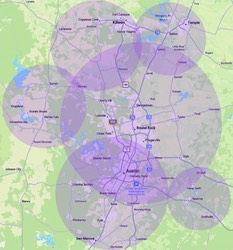Controlling Ball Moss & Mistletoe
Parasitic and invasive organisms work slowly, but they can damage your trees’ health. In Central Texas, two of the most common parastic and invasive organisms are:
- Ball Moss – an invasive organism;
- Mistletoe – a parasitic organism.
Ball moss and mistletoe can both pose serious issues to trees on your property or in your neighborhood. Both also spread easily.
Ball moss removal and mistletoe removal are important services we provide at Good Morning Tree Service. We have proudly serviced Austin, Texas, and the surrounding Central Texas area for over 20 years.
What is Ball Moss?
Ball moss are circular photosynthesizing plants, ranging in size from a golf ball to a softball. Ball moss is an invasive plant, not a parasite like mistletoe.
Ball moss grows well in areas with low light, little airflow, and high humidity. Unfortunately, these conditions are commonly provided by southern shade trees such as Live Oaks.

Ball Moss Proliferation
Ball moss proliferation has become a serious problem, killing thousands of acres of native Central Texas trees. Ball moss is widely present in Central Texas, mostly in Live Oak trees. Ball moss can overload a tree’s lower branches. It is often seen to be a precursor (but not the cause) of a tree’s death as the ball moss will concentrate on the dead and dying branches.
Ball Moss Removal
Ball moss is typically removed by hand. Alternatives include a high-pressure spray of plain water or a baking soda mixture, to slow down the ball moss’s attaching process. In the past, some arborists have removed ball moss using a fungicide that contains copper, but have since found that that process does not work very well.
Ball moss is airborne, so it is very difficult to completely and permanently remove it from all of your trees. If your neighbors still have ball moss, then you will again.
What is Mistletoe?
American mistletoe is an evergreen, seed-bearing, parasitic plant that affects hardwood trees. Mistletoe usually appears on hardwood trees after the leaves fall.
The mistletoe gets (steals!) water and nutrients from the host tree. Since its leaves contain chlorophyll, it can also produce its own food. The mistletoe plant thrives in sunlight, especially in the Central Texas area.
While mistletoe doesn’t usually kill the entire tree, it often stresses the tree’s overall health, and can kill some of the tree’s branches. However, if a tree is heavily infested, it may be stunted in its growth. Sometimes heavily infested trees lose so much vigor that they die.

Controlling Mistletoe
The only way to control mistletoe is to remove the plant, and its infested branches.
- Pruning out infected branches.
- Severe topping when trees are heavily infested
- If the mistletoe infection is severe, it may be best to remove the tree. This will stop the spread of mistletoe seed to other nearby trees
Mistletoe Resistant Trees
Some Central Texas tree species are resistant to mistletoe infestation:
- Chinese pistache
- Crape myrtles *
- Golden rain tree
- Persimmon
- Sycamore
(*) Crape Myrtle trees are the most common Central Texas trees that are resistant to mistletoe.
Mistletoe Susceptible Trees
These trees are more likely to suffer mistletoe infestation:
- Alder
- Flowering pear
- Ash
- Box elder
- Cottonwood
- Cedar elm (**)
- Hackberry (**)
- Locust
- Silver maple
- Walnut
(**) Cedar elm and Hackberry trees are the most common Central Texas trees that are susceptible to mistletoe infestation.
Professional Ball Moss & Mistletoe Control
At Good Morning Tree service, we’ve done our homework and we work hard to ensure ball moss removal and mistletoe removal are handled properly the first time around. Ball moss and mistletoe can return, it is a bigger threat to your trees to leave them unchecked. Contact us today to ensure the health and safety of your trees.
Free On-Site Estimates
7am – 7pm
7 days a week




